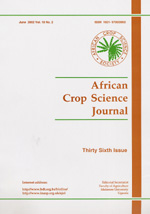
|
African Crop Science Journal
African Crop Science Society
ISSN: 1021-9730
EISSN: 1021-9730
Vol. 6, No. 2, 1998, pp. 171-178
|
 Bioline Code: cs98019
Bioline Code: cs98019
Full paper language: English
Document type: Research Article
Document available free of charge
|
|
|
African Crop Science Journal, Vol. 6, No. 2, 1998, pp. 171-178
| fr |
Giller, K.E.; Amijee, F.; Brodrick, S.J. & Edje, O.T.
Résumé
L'addition de la fertilisation de P (26 kg P ha-1) a beaucoup
augmenté
le nombre de nodules racinaires ainsi que le rendement en graines de
Phaseolus vulgaris
en champs des fermiers dans la région montagneuse ouest d'Usambar au
nord de la
Tanzanie. La nodulation et le rendement en graines variaient amplement
entre les
différents sites traités à la fertilisation. La
fixation de l'azote
atmosphérique était mesurée dans deux de ces essais
par la
méthode de dilution de l'isotope 15N avec une
variété non
nodulante de P. vulgaris servant de témoin non fixateur. En
l'absence de la
fertilisation, seulement 2 à 8 kg N ha-1 soient 25-27%,
dérivaient
de la fixation de N atmosphérique tandis qu'avec l'addition de 26 kg
P
ha-1, la fixation azotée était
élevée à 8-16
kg ha-1 soient 48-51%. La combinaison de Rhizobium avec
le fertilisant P
a légèrement augmenté la nodulation ainsi que la fixation de
N par rapport au
traitement de fertlisant P mais sans toutefois augmenter le rendement en
graines. Le rendement en
graines était légèrement amélioré par
l'addition de P et de N dans
les deux sites au sein de la région de Kilimanjaro/Meru au nord de
la Tanzanie. Dans l'une
de ces deux sites (Kilacha), le traitement au P a plus que tripplé
le nombre de nodules
tandis que la quantité d'azote total s'est légèrement
augmentée par rapport
au seul traitement de P. Le besoin de poursuivre ce genre de travail en vue
d'examiner la
nodulation et la fixation de N dans les conditions de sol qui
prévalent en plein champ des
fermiers est souligné.
Mots Clés
Inoculants, dilution de l'isotope 15N, fixation de N2, phosphore, rendement en graines
|
| |
| en |
Environmental constraints to nodulation and nitrogen fixation of Phaseolus vulgaris l. in Tanzania. II. Response to N and P fertilizers and inoculation with Rhizobium
Giller, K.E.; Amijee, F.; Brodrick, S.J. & Edje, O.T.
Abstract
Addition of P fertilizer (26 kg P ha-1) was shown to increase
dramatically the
number of root nodules and seed yields of Phaseolus vulgaris in
experiments on farmers'
fields in the West Usambara Mountains in northern Tanzania. Both nodulation
and seed yields
varied enormously between the different sites even where fertilizers were
applied. Nitrogen
fixation was measured in two of these experiments using the 15N
isotope dilution
method with a non-nodulating variety of P. vulgaris as a non-fixing
reference plant.
Without addition of P fertilizer the amount of N2 fixed was only
2-8 kg N ha-1
(25-27 %N derived from N2-fixation) and this was increased to
8-16 kg N ha-1
(48-51 %N derived from N2-fixation) with addition of 26 kg P
ha-1. Inoculation with Rhizobium together with P addition
increased
nodulation and N2-fixation marginally above that with P alone
but did not
increase seed yields. Seed yields were only marginally improved by addition
of P or N fertilizers at
two sites in the Kilimanjaro/Meru region of northern Tanzania. At one of
these sites (Kilacha)
inoculation with P more than trebled the number of nodules but only
marginally increased total N
accumulation. Across all sites, addition of N fertilizer (45 kg N
ha-1) increased
yields slightly above those found with P alone. The need for further
assessments of nodulation and
N2-fixation under soil fertility conditions prevailing on
farmers' fields is
emphasised.
Keywords
Inoculants, isotope dilution, N2-fixation, 15N, phosphorus, seed yield
|
| |
© Copyright 1998 - African Crop Science Society
|
|
